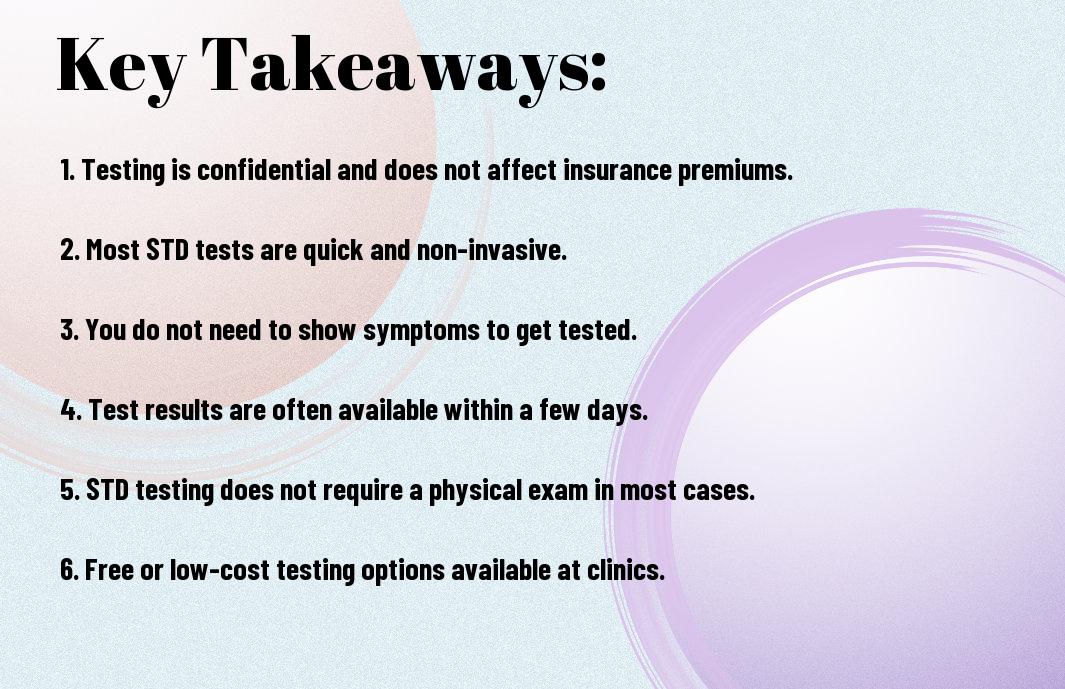Myths surrounding STD testing can lead to misinformation and potential health risks. This informative guide aims to debunk common misconceptions about STD testing, empowering readers with accurate knowledge. Understanding the importance of regular STD testing and breaking down barriers to seeking testing can contribute to a healthier society overall. Let’s research into the facts to separate truth from fiction when it comes to STD testing.
Key Takeaways:
- STD testing is not just for people with symptoms. It’s important to get tested regularly, even if you don’t have any symptoms.
- STD testing is confidential. Your test results are private and protected by patient confidentiality laws.
- STD testing is not just for certain age groups. Everyone who is sexually active should get tested, regardless of age.
- STD testing is quick and easy. Most STD tests are simple and can be done with a urine sample or a swab.
- STD testing is necessary for your health and the health of your partners. Getting tested regularly helps to prevent the spread of STDs and ensures early treatment if needed.

Myth-Busting 101
The
Importance of Accurate Information
Any discussion about STD testing must begin with the importance of accurate information. Having accurate information about STDs, testing procedures, and treatment options is crucial for maintaining one’s sexual health. Misconceptions and false beliefs can lead to misunderstandings, stigma, and ultimately, put individuals at risk.
The
Consequences of Misinformation
Misinformation about STD testing can have serious consequences. Believing common myths, such as “only promiscuous people get STDs” or “I would know if I had an STD,” can prevent individuals from seeking testing and treatment. This can lead to untreated infections, potential complications, and unknowingly spreading STDs to others.
Importance of seeking accurate information and debunking common myths cannot be overstated. It is important to promote education, awareness, and open communication about sexual health to ensure individuals make informed decisions about STD testing and protect themselves and their partners.

The Myths Surrounding STD Testing
Myth: STD Testing is Only for Promiscuous People
Testing may be stigmatized as something only necessary for individuals who are sexually active with multiple partners, but this is far from the truth. STDs can be contracted by anyone who is sexually active, regardless of the number of partners they have had. Getting tested for STDs is a responsible and important part of taking care of your sexual health, it is not a judgment on your lifestyle choices. Regular testing is recommended for all sexually active individuals, regardless of their relationship status.
Myth: You Can Tell If Someone Has an STD by Looking at Them
An individual’s appearance has no correlation with whether or not they have an STD. STDs can often present with no visible symptoms, making it impossible to tell just by looking at someone whether they are infected or not. It is dangerous to make assumptions about someone’s sexual health based on their appearance, as this can lead to misinformation and the spread of STDs.
Myth: STDs Are Only Spread Through Unprotected Sex
Spread: While unprotected sex is a common way for STDs to be transmitted, it is not the only way. STDs can also be spread through skin-to-skin contact, sharing needles, and from mother to child during childbirth. It is crucial to understand all the ways in which STDs can be transmitted to protect ourselves and our partners. Regular testing and practicing safe sex are important steps in preventing the spread of STDs.
The Truth About STD Testing
Despite the stigma surrounding STD testing, it is a crucial aspect of maintaining one’s sexual health. Regular testing can help detect and treat STDs early, preventing further complications and spreading the infection to others. It is imperative for everyone who is sexually active to get tested, regardless of age, gender, or sexual orientation.
Who Should Get Tested and How Often
About the frequency of STD testing, the general recommendation is for sexually active individuals to get tested annually or whenever they change sexual partners. Those with multiple partners or engaging in risky sexual behavior may need to get tested more frequently. It is also important for pregnant individuals to get tested for STDs to prevent passing the infection to their baby during childbirth.
The Types of STD Tests Available
One common misconception is that STD testing is a one-size-fits-all approach. In reality, there are various types of STD tests available, including blood tests, urine tests, swab tests, and physical examinations. The type of test you need depends on the specific STD you are being tested for and your healthcare provider’s recommendation. It is important to discuss your sexual history and any symptoms you may be experiencing with your healthcare provider to determine the most appropriate test for you.
- Blood tests: To detect infections such as HIV, herpes, and syphilis.
- Urine tests: To screen for infections like chlamydia and gonorrhea.
- Swab tests: Involving collecting samples from the genitals, mouth, or rectum for infections like chlamydia, gonorrhea, and HPV.
- Physical examinations: To visually inspect for genital warts or sores that may indicate an STD.
- Any combination of the above tests may be recommended based on your risk factors and symptoms.
Plus, it is important to note that some STDs, such as HIV, may not show immediate results after exposure. In such cases, healthcare providers may recommend retesting at a later date to ensure accurate results and early detection.
What to Expect During an STD Test
For individuals who may be feeling anxious or nervous about getting tested for STDs, it is imperative to know what to expect during the process. STD testing is typically quick, confidential, and relatively painless. The healthcare provider may ask about your sexual history, symptoms, and reasons for getting tested before proceeding with the test.
Shouldyou test positive for an STD, do not panic. Many STDs are treatable with medication, and early detection can prevent complications. Your healthcare provider will discuss treatment options with you and may recommend partner notification to prevent further spread of the infection.
Debunking Myths About Specific STDs
HIV: Separating Fact from Fiction
Not getting tested for HIV due to fear or stigma can lead to misconceptions about the virus. It’s crucial to debunk the myths surrounding HIV to promote accurate information and encourage testing.
Chlamydia: The Silent Infection
Silent misconception about chlamydia being asymptomatic can lead to delayed or undetected diagnoses. Chlamydia is the most common bacterial sexually transmitted infection in the United States, and routine testing is imperative to detect and treat it early.
Understanding the prevalence and consequences of chlamydia is key to dispelling the myth that it is harmless. Chlamydia can lead to serious health complications if left untreated, such as infertility and pelvic inflammatory disease. Regular screenings and safe sexual practices are vital in preventing and managing chlamydia infections.
Gonorrhea: The Growing Threat of Antibiotic Resistance
Myths about gonorrhea being easily treatable with antibiotics contribute to the growing threat of antibiotic resistance. Gonorrhea has developed resistance to various antibiotic treatments, making it more challenging to cure. This highlights the importance of regular testing and following medical guidelines for treatment.
Separating fact from fiction about gonorrhea’s resistance to antibiotics is crucial in preventing the spread of drug-resistant strains. Healthcare providers play a key role in promoting responsible antibiotic use and monitoring treatment efficacy to combat the growing threat of antibiotic-resistant gonorrhea.
Overcoming Barriers to STD Testing
Fear and Stigma: The Biggest Obstacles
Unlike what many people think, fear and stigma are the biggest obstacles preventing individuals from getting tested for STDs. The stigma surrounding sexually transmitted diseases can create shame and embarrassment, leading many to avoid seeking testing out of fear of judgment.
Overcoming these barriers requires a shift in mindset and education. It’s necessary to create a supportive and non-judgmental environment where individuals feel safe to seek testing and treatment without fear of stigma.
Accessibility and Affordability: Breaking Down Barriers
One of the significant hurdles in STD testing is the lack of accessibility and affordability. Many individuals may not have easy access to testing centers or healthcare providers, and cost can also be a barrier for some.
One way to address this is by increasing the availability of testing through community health centers, mobile clinics, and online testing options. Additionally, making STD testing more affordable or even free can help remove financial barriers for individuals seeking to get tested.
Normalizing STD Testing: A Call to Action
As a society, we need to break down the taboos and shame associated with STD testing. Breaking the silence and normalizing discussions about sexual health can help reduce the stigma and encourage more people to prioritize their sexual well-being.
This call to action involves promoting open and honest conversations about sexual health, encouraging regular testing as a standard part of healthcare, and educating individuals about the importance of knowing their STD status for their own health and the health of their partners.
What to Do If You Test Positive
Don’t Panic: Next Steps After a Positive Diagnosis
Keep calm and remember that receiving a positive STD diagnosis is not the end of the world. It’s crucial to take a deep breath, process the information, and understand that many STDs are treatable with proper medical care. The first step is to schedule an appointment with a healthcare provider to discuss your diagnosis and receive guidance on the next steps.
Treatment Options and Support Systems
Panic Positive STDs like chlamydia, gonorrhea, and syphilis can often be cured with antibiotics if detected early. It’s important to follow your healthcare provider’s recommendations for treatment to ensure a full recovery. Additionally, support systems such as counseling services, support groups, or online resources can provide emotional support and guidance throughout your treatment journey.
Plus, some viral STDs like herpes and HIV can be managed through antiviral medications and ongoing medical care. It’s necessary to work closely with your healthcare provider to develop a treatment plan that suits your individual needs and lifestyle.
Disclosure and Communication: A Delicate Balance
Steps After receiving a positive STD diagnosis, deciding whether to disclose your status to sexual partners can be a challenging and sensitive process. Support It’s important to prioritize open and honest communication while also considering your emotional well-being and safety. Seek guidance from your healthcare provider or a counselor on how to navigate these conversations with care and empathy.
To wrap up
Hence, it is important to educate ourselves and others about the truths surrounding STD testing. By debunking common myths and misconceptions, we can normalize the conversation around sexual health and encourage more people to prioritize regular testing. Be mindful of, getting tested is a responsible and empowering step towards taking care of our own health and the health of our partners.
FAQ
Q: What are some common myths about STD testing?
A: One common myth is that STD testing is painful or embarrassing, but in reality, it is a simple and quick process that can be done discreetly.
Q: Is it true that only people with symptoms need STD testing?
A: No, many STDs do not always show symptoms, so it is important for sexually active individuals to get tested regularly, regardless of symptoms.
Q: Do I need to see a healthcare provider for STD testing?
A: While seeing a healthcare provider is one option, there are also home testing kits available that make testing convenient and accessible.
Q: Are STD tests expensive?
A: STD testing can vary in cost depending on where you go, but many clinics offer free or low-cost testing options, and some health insurance plans cover the cost of testing.
Q: How long does it take to get STD test results?
A: The time it takes to get STD test results can vary depending on the type of test, but many tests provide results within a few days to a week.



